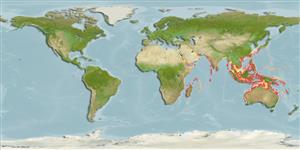Classification / Names
Common names from other countries
Main reference
Size / Weight / Age
Max length : 31.0 cm SL male/unsexed; (Ref. 44894); common length : 20.0 cm SL male/unsexed; (Ref. 9679); max. reported age: 7 years (Ref. 43081)
Length at first maturity
Lm 22.5, range 13 - 19.1 cm
Environment
Marine; brackish; reef-associated; amphidromous (Ref. 51243); depth range 0 - 60 m (Ref. 6205), usually 0 - 2 m (Ref. 90102)
Climate / Range
Tropical; 26°C - 29°C (Ref. 4959), preferred 27°C (Ref. 107945); 41°N - 36°S, 20°E - 166°E (Ref. 6205)
Distribution
Indo-West Pacific: southern Red Sea (Ref. 94953) and Knysna, South Africa to Japan and south to Australia. Reported from New Caledonia (Ref. 9070). In Japan, this name has often been misapplied to Sillago japonica; often misidentified as Sillago lutea or Sillago vincenti.
Countries | FAO areas | Ecosystems | Occurrences | Introductions
Short description
Dorsal
spines
(total): 11 - 13;
Dorsal
soft rays
(total): 20-23;
Anal
spines: 2;
Anal
soft rays: 18 - 23. Swim bladder with two anterior and two posterior extensions. The anterior extensions extend forward and diverge to terminate on each side of the basioccipital above the auditory capsule. Two lateral extensions commence anteriorly, each sending a blind tubule anterolaterally and then extending along the abdominal wall below the investing peritoneum to just posterior of the duct-like process. Two posterior tapering extensions of the swim bladder project into the caudal region, one usually longer than the other. The species has a low lateral line with about 70 scales (Ref. 48635).
IUCN Red List Status (Ref. 115185)
Threat to humans
Harmless
Human uses
Fisheries: commercial; aquaculture: commercial
Tools
Special reports
Download XML
Internet sources
Estimates of some properties based on models
Phylogenetic diversity index
PD50 = 0.5000 many relatives (e.g. carps) 0.5 - 2.0 few relatives (e.g. lungfishes)
Trophic Level
3.3 ±0.1 se; Based on diet studies.
Resilience
High, minimum population doubling time less than 15 months (K=0.75-1.22; tm=1; tmax=4; Fec=16,682)
Vulnerability
Low vulnerability (24 of 100)
Price category
